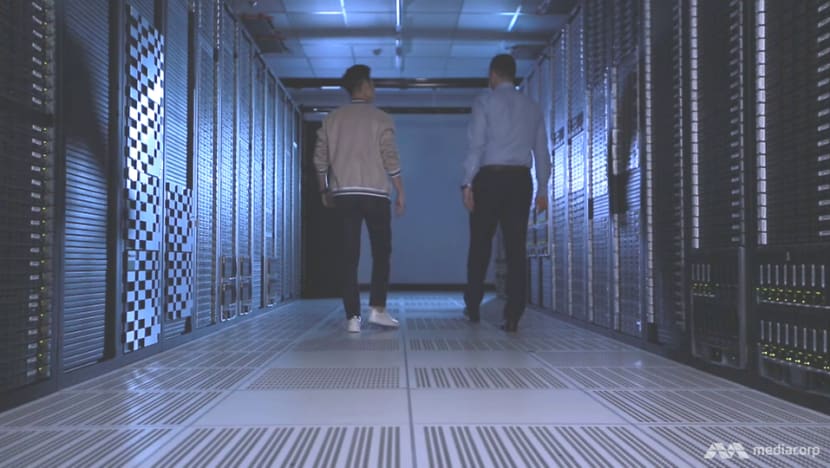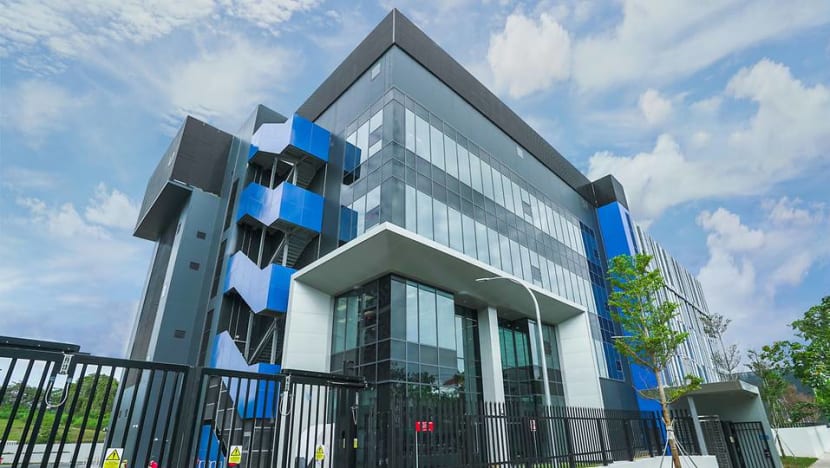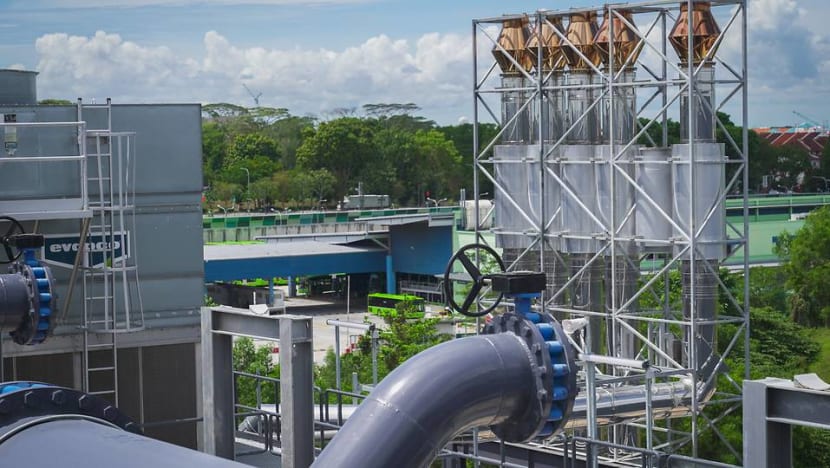Singapore puts ‘temporary pause’ on new data centres: Why and what it means for the industry

Email, videos, social media content — anything you do online — are stored in data centres like these. (Source: Mediacorp)
SINGAPORE: With consumers and businesses gobbling up more data in an increasingly connected world, data centres are in hot demand.
Packed with rows and rows of servers, they store, process and communicate data produced every single day, forming the backbone of a booming digital economy around the world.
This demand will only increase, hastened by the COVID-19 pandemic and new technologies such as 5G, artificial intelligence and the Internet of Things.
“(The) technologies will drive demand for greater data and computing capacity, leading to a rise in data centre infrastructures,” said Mr Richard Farrell, the Asia-Pacific director for cloud and data centre segment at power management firm Eaton.
But data centres are also huge energy hogs – everything from the servers, storage equipment and cooling infrastructures have a large appetite for electricity.
The International Energy Agency estimates that the sector currently uses around 1 per cent of the world’s electricity. This figure could hit double-digits by 2030, making related emissions a problem.
READ: Singapore must ensure digital infrastructure is environmentally sustainable, says Desmond Lee
In Singapore, data centres accounted for about 7 per cent of the country’s total electricity consumption last year, said the Ministry of Trade and Industry (MTI) in a recent written answer to a parliamentary question.
There are about 60 data centres in Singapore, according to a tally by research firm Structure Research.
“QUALITY, NOT QUANTITY”
There has been a “rapid increase” in the number of data centres being approved to be constructed on industrial state land over the past five years, MTI said in a separate written parliamentary reply on Feb 1.
Fourteen data centres with a total IT capacity of 768 megawatts were given the green light during that period, compared to 12 data centres carrying 307 megawatts in the preceding five years.
With the industry being an “intensive” user of electricity and water, a “temporary pause” has since been imposed on the building of new data centres as local authorities mull a balance between environment sustainability and supporting business needs.
“The Government therefore decided to moderate the growth of data centres with a temporary pause on the release of state land for data centres, as well as the development of data centres on existing state land,” MTI’s reply said.
It added that the industry was informed of the decision in 2019 and has been consulted on ideas for a more sustainable growth.
“We will strive for quality, not quantity – this means we seek to anchor a range of data centres that can meet both industry and society’s needs, are best in class in terms of resource efficiency, and that continuously innovate to push the boundaries of resource efficiency … in a tropical climate,” MTI said.
The Government has said it intends to share its plans later this year after concluding its review.
READ: Commentary: When our insatiable appetite for data can harm the environment too
Industry experts told CNA that the Government’s decision comes as no surprise, given the country’s land and power constraints.
Singapore is not alone in doing so. Amsterdam, the capital of the Netherlands, hit the brakes on new data centres in July 2019, citing strains on its property market and power networks. The ban was lifted after a year under conditions such as locating data centres in specific zones with limits on power use and floor space.
“Singapore is a relatively smaller city-country, when compared to the other tier-1 markets such as Tokyo, Sydney and Hong Kong. Yet we come in second in terms of IT capacity,” said Ms Lim ChinYee, senior director of Asia-Pacific data centre solutions at CBRE.
“It is therefore important that Singapore ensures that the overall data centre ecosystem is environmentally sustainable, while balancing the need for growth.”
Mr Farrell thinks this offers Singapore “a timely opportunity” to invest in green technologies, higher-performance infrastructure and develop technology talent.
“This will help the country keep up with future expansion in data centre demand when the moratorium is lifted,” he said.

ANY IMPACT?
But with supply being curbed at a time of booming demand, rental rates at data centres based on cost per kilowatt have surged by more than 30 per cent last year, said Mr Lynus Pook, Colliers’ senior director of industrial advisory in Asia.
These rates have stayed low from 2016 to 2019, especially in 2018 when vacancy rates peaked at 40 per cent due to new supply.
“With the temporary pause in building new data centres, the vacancy rates have narrowed to 5 per cent in 2020, leading to some spill-over in demand to neighbouring countries such as (Malaysia) Johor Bahru,” said Mr Pook. “Inevitably, rental rates have increased by more than 30 per cent.”
Ms Lim expects rental rates to continue heading north over the next three years, given a tight supply and expectations that the moratorium on constructing new data centres will be lifted by 2022.
Singapore has been a popular site to build data centres due to factors such as a reliable power grid and a business-friendly environment. So far, it remains the case even with the ongoing moratorium, industry observers said.
READ: Zoom opens new data centre in Singapore
For instance, Singapore came in second in a recent list of top data centre markets by Arcadis, coming just behind the United States, due to political stability, a well-educated workforce and the ability to attract major technology investments.
“Rather than the moratorium being considered off-putting for potential data center providers, it has forced them to rethink their current strategies and look for alternative models, as they have already started to do globally anyway,” said Mr Richard Warburton, growth director for Southeast Asia at Arcadis.
He pointed to announcements by companies such as Facebook and Amazon that will be tapping renewable energy to power their data centres in Singapore.
“Overall, it's unlikely that the moratorium will deter providers from investing in Singapore in the mid to long term,” said Mr Warburton, adding that it is “only natural” for data centre operators to move into regional markets as part of their expansion plans.
“Alternative data centre hubs are emerging across the region in response to increasing demand and corporate strategies, rather than as a reaction to the moratorium,” he added.
WHY SINGAPORE?
Industry players told CNA they are still keen to have more of their data centres located in Singapore.
Tencent Cloud, for example, hopes to add one more to its current portfolio of two here, as Singapore remains a “very important market” to the company’s strategic growth in Southeast Asia.
“Although land scarcity and regulations remain a challenge, we plan to build at least one more (data centre) in the country to meeting the growing demands from our customers,” said Mr Poshu Yeung, senior vice-president of Tencent Cloud International.

Equinix is set to open its fifth data centre in Singapore in the second half of the year. The site was acquired before the moratorium by local authorities.
For the company, Singapore remains an attractive data centre hub in Asia Pacific, with advantages such as a strong subsea cable network and low risks of natural disasters outweighing the challenges.
The country is also located at the centre of an “explosive” growth for the industry, said Ms Leong Yee May, managing director for Equinix South Asia.
“Across Asia-Pacific, there has been tremendous growth in demand for data centres and this trend is likely to continue,” she said, citing reports that expect the region’s data centre colocation market to grow at a compound annual growth rate of more than 8 per cent between 2018 and 2024.
“As we close off the financial year of 2020, Equinix reported a 14 per cent year-on-year increase in our Asia-Pacific revenue growth. Singapore contributes significantly to that and this shows that there continues to be demand for cloud connectivity and digital infrastructure as enterprises transform digitally,” added Ms Leong.
That said, it takes 18 to 24 months to get a data centre up and running and there could be “diminishing returns” if the current construction halt persists for long, said Mr Mark Smith, Digital Realty’s managing director for Asia Pacific.
“If we can build another data centre in Singapore, we would tomorrow. But even when the moratorium on approvals is lifted, it still takes 18 to 24 months to build a data center,” he said.
“There will be a delay … and I do think you start to get a law of diminishing returns the longer the moratorium continues.”
THE WAY FORWARD
Industry players like Digital Realty and Equinix said they have been in touch with local authorities with suggestions on how their industry can be more environmentally friendly.
Last month, Digital Realty powered on its third and largest data centre in Singapore, which it described as one of its most sustainable in the region.

Called the Digital Loyang II or SIN12, it includes a new cooling system to help minimise evaporation losses and improve water-use efficiency. Turbine generators, instead of diesel engines, are also used to enable cleaner emissions while getting the same amount of energy output.
Operating a data centre in Singapore has its unique challenges, said Mr Smith. For example, Singapore’s tropical climate means that 35 to 40 per cent of the energy consumed by a data centre here goes to cooling.
New solutions will hence be crucial. Digital Realty is currently partnering CoolestDC, a company set up by a research team from the National University of Singapore, to test the latter’s liquid cooling idea.
“Using CoolestDC’s liquid and two-phase cooling solutions can result in up to 30 per cent savings in the total energy consumption for data centres. Related to this will be the significant reductions in carbon dioxide emissions and water consumption,” it told CNA.
Plans are also ongoing to upgrade Digital Realty’s other data centres – SIN10 at Jurong and SIN11 at Loyang – so as to improve their power usage effectiveness (PUE), said Mr Smith.
These currently have a PUE of 1.56 and 1.32, respectively, compared with SIN12’s 1.25.
WATCH: Floating data centre being developed to overcome land, energy constraints
The PUE is a measure of a data centre’s energy efficiency, where the ratio of total energy used is divided by energy consumed for information technology activities. The theoretical ideal PUE is 1, where 100 per cent of electricity consumption goes toward useful computation.
Equinix said its data centres in Singapore run fully on renewable energy and are “certified to meet rigorous environmental and energy standards”.
Innovative technologies have also been deployed, such as a temperature control system that has improved the PUE of its first data centre here by 15 per cent. Its third data centre also uses recycled rainwater and is installed with solar photovoltaic systems to supplement power from the local grid.
Similarly, the upcoming data centre will have several green features, including motion-activated LED lights, automated control and regulation of motors, as well as using NEWater for cooling purposes.
READ: Commentary: The world is hungry for green cooling solutions. Thankfully, Singapore is pioneering them
At Tencent Cloud, it said it “preferentially selects sites rich in waste-to-energy recovery and clean energy resources and maximises the utilization of green energy”.
It has also developed artificial intelligence and machine learning technologies for capacity control and PUE optimisation. As a result, energy efficiency levels at its data centres have improved from 1.8 to 1.2 over the years, said Mr Yeung.
Other ideas are also being explored, such as how Keppel Data Centres is thinking of having floating data centres out at sea.
Mr Farrell said the shift to sustainable data centre growth is “both an environmental and business imperative”.
“Business leaders will need to demonstrate how achieving such sustainability targets can deliver long-term value to stakeholders and consumers, in order to secure the buy-in needed to get these projects off the ground,” he added.
“Proving the viability and long-term success of such investments will serve as a catalyst for others to explore more new solutions to achieve their sustainability goals.”
Mr Pook thinks local authorities will likely “be selective in their approval process” moving forward, with other considerations such as an operator’s value-add apart from capital expenditure and job creation possibilities.
“Clearly the authorities do not want the Singapore to just be a data warehouse. We want meaningful data to be stored in Singapore,” he said.















